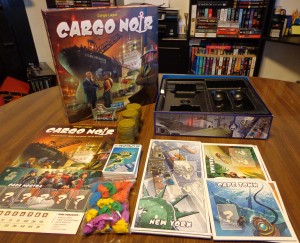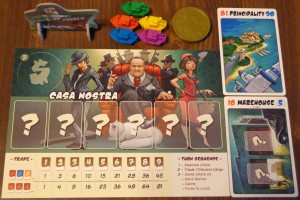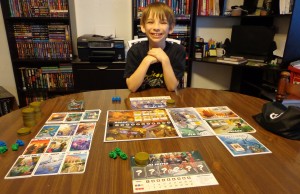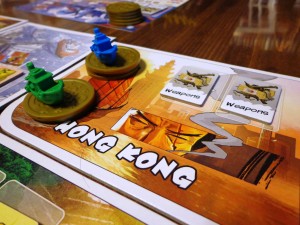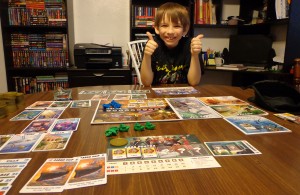I’ve had the pleasure of playing and reviewing quite a few worker placement games this year…Agricola, Lords of Waterdeep, and Stone Age, just to name a few. I was surprised to learn about Cargo Noir, having never heard of it until last week when I visited a local board game store for the first time (amazing experience, by the way).
Cargo Noir is a worker placement game that tasks players with acquiring goods so that they can be traded in for victory point cards. Players will be assigned a number of ships in the beginning of the game and will have to decide how best to use them to acquire said goods. Let’s take a brief look at the game itself before heading into the review.
Components
Macao and Port Boards – These separate boards make up the main playing area and allow players to perform different kinds of actions.
Cargo Tokens – There are nine separate cargo types and a set of wild tokens that players will be collecting and eventually trading in to purchase victory point cards.
Victory Point Cards – Players will be trying to acquire these by trading in goods. Some cards give players a nice chunk of victory points (victory spoils) while others provide bonuses (smuggler’s edge) that can be used during the game, like adding another ship to their fleets, for example.
Cargo Ships – Players will be using cargo ships to indicate where they’d like to take actions.
Family Sheets – Each player receives their own family sheet, which they use to manage their money and the goods that they’ve collected (which are stored in warehouses).
Gold Coins – Players will be acquiring and using gold coins in order to bid on goods at a port.
First Player Marker – The first player marker stays with the first player to remind all players as to when a full turn is over and when it is appropriate to move the turn marker along the track.
Setup
The boards are laid out in between players, though not all of them may be used, depending on how many people are playing the game. All of the cargo tokens (except for the wilds) are mixed up the bag provided with the game. Wild tokens are placed into the bag at a ratio of one per player. Cargo tokens are then drawn from the bag to fill all of the spaces on the available boards. Each player receives three ships of their color, seven coins, and a family sheet. All of the victory cards are separated into their own piles and the first player is given the first player marker. This player will move the game turn marker along the track at the beginning of their turn. At the beginning of the game, the marker will be moved to “1”.
Gameplay
As I’ve stated above, Cargo Noir is a worker placement game. Thus, a lot of the game will be placing ships and resolving actions, though not in that particular order. Let’s briefly go over what a player does on their turn.
1) Resolve Ship Actions – The current player can resolve their ship actions in any order they wish, one at a time. Players that have bid on a port in phase three will look to see if any other colored ships occupy the same port…if not, they buy all of the cargo there for the money they bid with. If there is another ship there, they can increase their bid so that it is more than their opponent’s bid, or bring the ship back to their player sheet along with their bid. Cargo tiles are replaced via the bag / pool as they are bought from a dock. The Macao location allows players to swap resources at the black market or draw one at random, as well as earn two gold pieces from the casino.
2) Trade Cargo for Victory Point Cards – The current player can trade in cargo for their choice of victory cards. The value of the cargo traded is indicated on the family sheet. It’s important to note that no change is given, so it is encouraged to only trade in what you need to for the cards that you want.
3) Place Ships – The current player can place their ships on spaces one at a time, but do not resolve any actions until phase one of their next turn. When placing a ship at a port, the player will include a number of coins as their bid for the goods located there. Other players will have a chance during their turns to compete and bid for those same goods, until only one ship is left standing. It is possible for the game to advance a few turns on the track while players outbid each other at a particular port on their respective turns.
Obviously, phases one and two cannot be done on the very first turn. Players will skip to phase three during their first turn only.
Endgame & Scoring
Once the turn track marker reaches the “11”, each player takes one last turn. During this turn’s phase two only, players can use coins in addition to their goods to acquire victory points. After everyone has taken their turn, the game ends, and whoever has the most victory points via the cards they’ve acquired wins!
The above is simply an overview of the game. If you’d like to read more, then please check out the manual, located here:
The Review
First, let me get my sole complaint with the game out of the way. It’s relatively minor, but still noteworthy. While the box insert is decent at what it does, the spaces aren’t large enough to hold all of the cargo piece tokens. I personally lifted the box insert up and put the bag of tokens underneath, spreading the bag out as much as possible so that it stays flat. This partially works, but I still use a rubber band to keep the lid on. I did some research and others have come across the same issue and developed their own solutions. One individual was able to cram all of the cargo tokens into the slots while others just dumped the cargo tokens under the insert without the bag. Another crafty individual cut out part of the insert…again, this is minor, but in my opinion a box insert should be user-friendly to everyone who purchases a game.
Now that my only complaint was addressed, I can safely say that Cargo Noir is a fantastic game. The components are full of theme and instructions are laid out well, though it is easy to mix a few things up if new players don’t read the directions carefully (especially in the area of player turns and how the phases work).
While there is a bidding mechanic, it does not make or break the game. Players are free to choose other ports or swap resources at the black market as an alternative to playing “bid wars.” The addition of more than one port and the inclusion of nine cargo types keeps things varied enough to where it is rare to see all players gathered around one port for the resources located there. Since players can trade in different cargo tokens OR like cargo tokens to acquire victory cards, players may decide to gobble up any cheap resources they can get their hands on and save their money for the last turn’s phase two. Giving players the option to buy cards that provide bonuses certainly adds more strategic depth to it all.
Cargo Noir would make an excellent game in introducing new players to the worker placement mechanic. I originally used Stone Age as the introductory game, but I found Cargo Noir to be slightly easier as there is less to keep track of, not to mention faster to play. Overall, it is a good, solid game that I’ll be coming back to when time permits.
Final Verdict: 7/10
—

